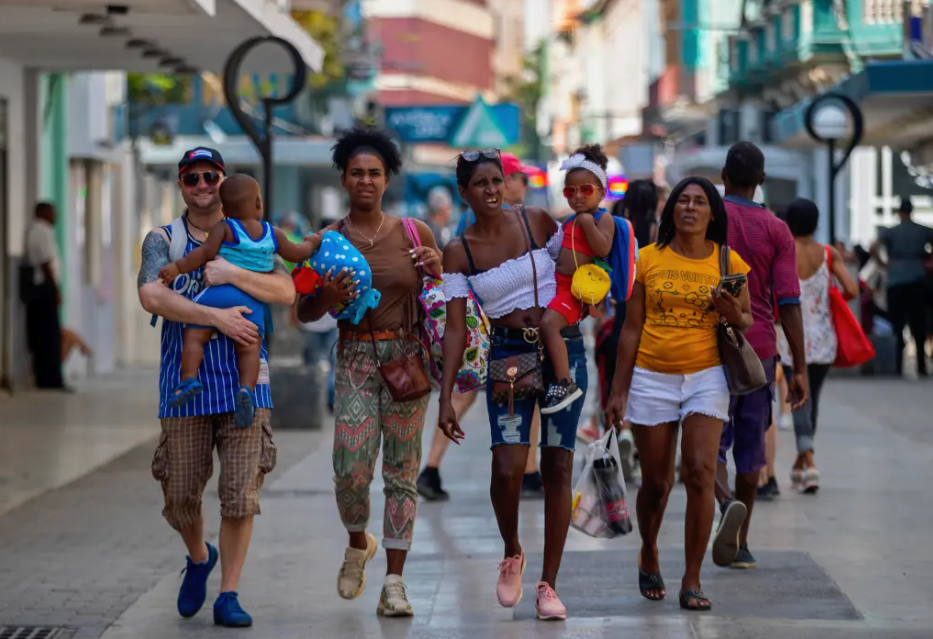According to the Population and Housing Census, in September 2012, there were 11,167,325 permanent residents in Cuba. The most current official figure is provided by the summary Demographic Indicators of Cuba and its Territories, 2022, of the National Office of Statistics and Information (ONEI): 11,089,511 inhabitants by December 31, 2022.
This last figure will be disregarded, since it is only the result of the mentioned statistical institution’s estimations and not of an exhaustive count, as is the case of any census. Indeed, it is hardly credible that between the 2012 Census and the end of 2022, with the mortality rate growing (from 7.9 per thousand in 2012 to 9.8 per thousand in 2019) and the birth rate falling (from 10.4 in 2016 to 8.9 in 2021), with the facilities for emigration approved since 2013, and which in the past two years have taken half a million Cubans to the United States alone, the country’s population will only be reduced by a little less than eighty thousand inhabitants.
Undoubtedly, a more convenient choice of the most updated population figure would have been to use the one provided by the Census that should have been taken in 2022. However, the Cuban regime has postponed it to the first four months of 2025.
We are left to use the figures of the Electoral Roll for these elections of March 26. In Cuba, the Electoral Roll tends to have an accuracy close to that of a census, because here voters are included ex officio, without the need for the citizen to request it, in the electoral registers of their place of residence. Furthermore, the need of the regime to avoid high percentages of absenteeism at the polls, which are interpreted as oppositionist attitudes, forces it to do what it does not do when calculating the real resident population in the country: to deduct all those who have already emigrated without the intention of returning, and who are evidently kept as resident population in the ONEI reports. This need to show high levels of participation leads the government to place polling stations even in hospitals, so that the sick patients and their companions can vote, or to appoint people to take the ballots to the homes of those who for one reason or another cannot walk to the polls.
In order to estimate the total population in Cuba based on the electoral roll as of last March 26, we only need to know, in addition to the number of registered voters, the number of children under 16 years of age, that is, the sector of people who are not allowed to vote because of their age, and the percentage of the population of voting age that historically the Cuban electoral system does not register.
On March 26, after the update of the electoral roll after the elections, there were 8,129,321 registered voters in Cuba. On the other hand, according to the Statistical Yearbook of Cuba, 2021, by December 31 of that year the number of children under 16 years was 1,862,002. This data, which is the only one we can access, besides its remoteness from March 26, 2023, is itself problematic, being part of a distribution of inhabitants by age whose total sum results in the questionable value of 11,113,215. Nevertheless, since we have nothing better at hand, we will use it, even knowing that this value of the population under 16 years of age is inflated. As will be seen, we will try in the end to somewhat correct the error introduced by this figure.
To determine the percentage of the population that is not registered in Cuba, we will use the legislative elections of February 3, 2013, because for that electoral process, we have the most credible population figure of recent years, the one obtained by the Population and Housing Census of September of the previous year (there are only four months between the Census and the election): 11,167,325 inhabitants. From this number, we will subtract the number of children under 16 years of age, which according to the aforementioned Census was then 2,099,457, which leaves us with 9,067,868 inhabitants with the necessary age to vote. Finally, we will calculate what percentage of that number represents the electoral roll of the referred national elections, 8,668,457: 95.59%.
Since there has been no change in the electoral registration system, or in general in the organization of Cuban society, that would explain a variation in that percentage, we will use it to calculate, from the corresponding electoral roll, the population aged 16 years or older on March 26, 2023: 8,504,363 inhabitants.
If to this number of people aged 16 and over we now add the number of minors under that age that, according to the 2021 Yearbook reside permanently in Cuba, despite being inflated, we will have an estimate (at high) of the real population in Cuba on March 26, 2023: 10,366,365 inhabitants. A figure that corresponds to 93.47% of the supposed population of the island for three months earlier, according to ONEI in its mentioned Demographic Indicators of Cuba and its Territories, 2022.
This last percentage allows us to make one more correction: we can assume that the population under 16 years of age is likewise 93.47% of that registered for December 31, 2021, and use this somewhat lower figure in our calculation: 1,740,413, which, added to the aforementioned 8,504,363, gives us a slightly more accurate estimate of Cuba’s population for last March 26: 10,244,776 inhabitants. This is a decrease of 922,549 inhabitants since the 2012 Census.
As a result, the population decrease in Cuba in these thirteen years has been -7.62%. It is comparable, in the same period (2012 to 2021), to that of countries such as Lithuania (-6.26%) or Latvia (-7.37%), and much higher than that of Japan (-1.53%). Cuba’s performance is very similar to that of Puerto Rico (-10.21%), the country with a population greater than 100,000 inhabitants with the greatest decrease in the period.
Cuba’s current population, according to our calculations based on the latest Electoral Roll, is what the estimates of the last decade suggested it would have by 2050: 10.2 million.
*Translated from Spanish by Micaela Machado Rodrigues
Autor
Graduado en Formación Literaria por el Centro Onelio Jorge Cardoso y en Educación Sociopolítica por el Instituto Superior de Ciencias Religiosas a Distancia San Agustín, de la Univ. Católica de Valencia San Vicente Mártir.











